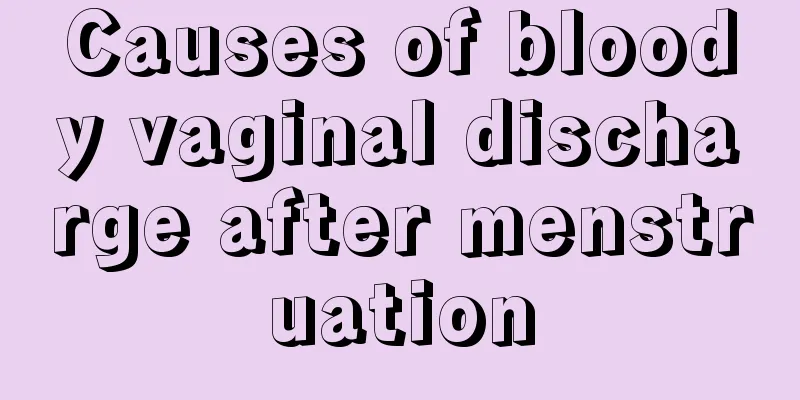Nosebleeds have local and systemic factors. It is crucial to stop the bleeding correctly and find out the cause!

|
Author: Li Xiaoting, attending physician, Beijing Chaoyang Hospital, Capital Medical University Reviewer: Zhang Juan, Chief Physician, Beijing Chaoyang Hospital, Capital Medical University When it comes to nosebleeds, I believe you must be familiar with them. This disease is one of the most common ear, nose and throat emergencies in daily life. Both adults and children may suffer from sudden nosebleeds. It occurs suddenly and progresses rapidly. When the amount of bleeding is large, it often cannot stop on its own and requires medical treatment. So, what are the causes of nosebleeds? What are the characteristics of nosebleeds in different age groups? The following will introduce them to you one by one. Characteristics and common causes of nosebleeds in children: About half of children have experienced nosebleeds at least once, which shows how common nosebleeds are in children. Most nosebleeds in children occur in the front part of the nasal cavity, that is, Little's area in the front and lower part of the nasal septum. This area has dense arteries and is relatively superficial, which can easily cause bleeding. The most common cause of nosebleeds in children is inflammation, including acute/chronic rhinitis, allergic rhinitis, etc., so it also shows the characteristics of the disease that are obviously related to the season. During the spring and autumn seasons in the north, rhinitis is caused by dry air, and the number of children with allergic rhinitis increases sharply, which often becomes a high-incidence period for nosebleeds. At this time, nosebleeds are not only caused by inflammation itself, but also often because children cannot tolerate nasal itching, and repeatedly blow their noses, rub their noses, pick their noses, sneeze, and other actions that damage the nasal mucosa. Parents should pay attention to the time of onset of allergic rhinitis in their children, and actively treat it by using glucocorticoid nasal sprays and oral antihistamines to control inflammation and relieve symptoms. At the same time, sea salt water, normal saline, nasal lubricants, peppermint oil drops, etc. can be used to protect the fragile nasal mucosa and prevent nosebleeds. Parents should also strengthen their children's education to avoid picking their noses. After the damaged mucosa is scabbed and naturally repaired, the symptoms of nosebleeds can be relieved. Children are naturally active and curious. They may put foreign objects into their nasal cavity during play, such as peanuts and toy parts. They cannot take them out by themselves, and they choose to hide it for fear of being scolded by their parents. Over time, the nasal mucosa will be damaged and compressed and eroded, causing nose bleeding and nasal odor, which can be smelled by parents. At this time, you should take your child to see a doctor as soon as possible and ask the doctor to check and remove the foreign object. Nosebleeds may also be a sign of a nasal tumor. Fibroangioma in the nasopharynx is common in adolescent males aged 14-15. Since the tumor itself has abundant vascular tissue, once it occurs, the amount of bleeding is large and difficult to stop on its own. Malignant tumors in the nasal cavity, sinuses and nasopharynx, such as lymphoma, often bleed due to tumor ulceration. Therefore, if nosebleeds occur frequently and gradually worsen, and there are symptoms of continued worsening nasal congestion, the child should be taken to the doctor for examination in time. In addition to the above-mentioned nasal diseases, other systemic diseases can also cause nosebleeds, such as hemophilia, thrombocytopenic purpura, leukemia and other blood system diseases; renal failure, liver failure, etc. Characteristics and common causes of nosebleeds in adults: Unlike children, the location of nosebleeds in adults is more complex, which may be Little's area, olfactory fissure, or inferior meatus dome. For the elderly, bleeding in the posterior nasal cavity is more common. Contrary to what many people think, high blood pressure is actually one of the common causes of nosebleeds in adults. Hypertension is an important cause of stroke, and blood vessels outside the skull can also rupture due to increased blood pressure, and blood vessels in the nasal cavity are no exception. If it is arterial bleeding, the amount of bleeding is large and cannot stop bleeding by itself, and medical treatment is often required. Therefore, when blood pressure is poorly controlled or unstable, nosebleeds are difficult to control effectively. In addition, oral anticoagulants, such as aspirin, clopidogrel, etc., may cause persistent and difficult to stop nosebleeds due to decreased coagulation function. Abnormalities in the nose's anatomy may cause nosebleeds, such as local stenosis caused by a deviated nasal septum. When air flows through, strong negative pressure will be generated, causing superficial blood vessels to rupture and bleed. Tumors occurring in the nasal cavity, paranasal sinuses, and nasopharynx can also cause nose bleeding. Since the bleeding is caused by ulceration on the surface of the tumor, rather than direct rupture of blood vessels, the amount of bleeding is relatively small, often manifested as persistent and gradually increasing blood in the mucus. Compared with children, the incidence of nasopharyngeal cancer in adults is higher, and its characteristic manifestation is blood in the mucus. Figure 1 Original copyright image, no permission to reprint In addition, systemic diseases, such as advanced blood disease, renal failure, repeated dialysis, liver damage, and decreased prothrombin, can also lead to diffuse nasal bleeding. There are also some rare genetic diseases, such as hereditary telangiectasia, which can easily lead to bleeding due to increased vascular fragility. For adolescent girls, frequent nose bleeding may occur during menstruation or before menstruation, which may be related to the fragility of capillaries caused by endocrine disorders. When adults seek medical attention for nosebleeds, they should first control their blood pressure, then find the bleeding point and give appropriate treatment. For controlled nosebleeds, appropriate examinations should be selected by asking about the medical history, excluding systemic diseases, and treating the cause of the bleeding. What should you do if you have a nosebleed? In daily life, when you notice a nosebleed, you will unconsciously tilt your head back, but this is actually the most incorrect way to deal with it. When you tilt your head back, the blood cannot flow out of the nasal cavity, but will flow into the throat, which can easily be inhaled into the respiratory tract and cause suffocation; or swallowed into the stomach, causing nausea and vomiting. Therefore, when you have a nosebleed, you should keep your head tilted forward to let the blood flow out of the nostrils. This will make it easier to estimate the amount of bleeding and prevent the blood from flowing into the throat and stomach. For children with nose bleeding, if the amount of bleeding is not large, parents should comfort the child to relieve his or her nervousness, and at the same time let the child lower his or her head slightly and press the nose wing on the bleeding side with the thumb for 5-10 minutes. If the nose bleeds still occur after pressing, seek medical attention in time. For ongoing nose bleeding, hemostasis treatment should be performed first, such as nasal packing, and other examinations such as nasal endoscopy, blood routine, CT, MRI, etc. should be performed on this basis to determine whether there are diseases such as inflammation or tumors and blood system diseases. It should be noted that parents should master the correct use of nasal spray hormones to prevent damage to the nasal septum mucosa caused by bad operating habits. At the same time, they should pay attention to correcting children's bad habits such as frequent nose picking, and pay attention to maintaining appropriate air humidity to avoid damage caused by dry mucosa. Figure 2 Original copyright image, no permission to reprint For adult nosebleeds, self-treatment can also be done by tilting the head forward, pressing the nose wings, or using cotton or soft cotton towels for packing. Generally, continuous pressure or packing for about 15 minutes can temporarily stop the bleeding. Avoid using toilet paper for packing, as it is easy to break and may remain in the nasal cavity, increasing the risk of aspiration. In addition, spraying the forehead with cool water or applying a cold towel to the forehead can reduce bleeding by constricting facial blood vessels, but its effect is not as significant as packing to stop bleeding. After initial hemostasis treatment, you should seek medical attention promptly so that the doctor can take further hemostasis measures and then investigate the cause of the bleeding after the bleeding stops. |
Recommend
What causes nipple pain?
Breasts are a very beautiful part of a woman'...
Which days are safe periods?
We all know that the few days before and after a ...
How can women nourish the liver and kidneys?
Women should pay more attention to protecting the...
Where is the cervix?
During a gynecological examination, the cervix is...
What medicine should women use to relax their private parts
Women all want to make themselves younger, especi...
The pros and cons of sleeping naked for girls
Naked sleeping refers to sleeping naked. It can a...
Reasons for weight gain during menstruation
Every woman wants to lose weight so that she can ...
Can I eat dragon fruit during my period?
Women during menstruation should pay attention to...
[Medical Q&A] How to take good care of your skin after staying up late?
Planner: Chinese Medical Association Reviewer: Zh...
Why do the leaves of the iron tree always turn white? How to remedy the whitening of the leaves of the iron tree
Speaking of cycads, I believe everyone is familia...
Is endometrial hyperplasia serious?
When it comes to endometrium, female friends are ...
I always feel unhappy. Am I suffering from depression?
I've been feeling very irritable lately. Ever...
What is the best way to treat pelvic inflammatory disease?
The pelvic cavity is the most important part of t...
The best time and precautions for pregnancy check-ups
Pregnancy is something every woman will experienc...









